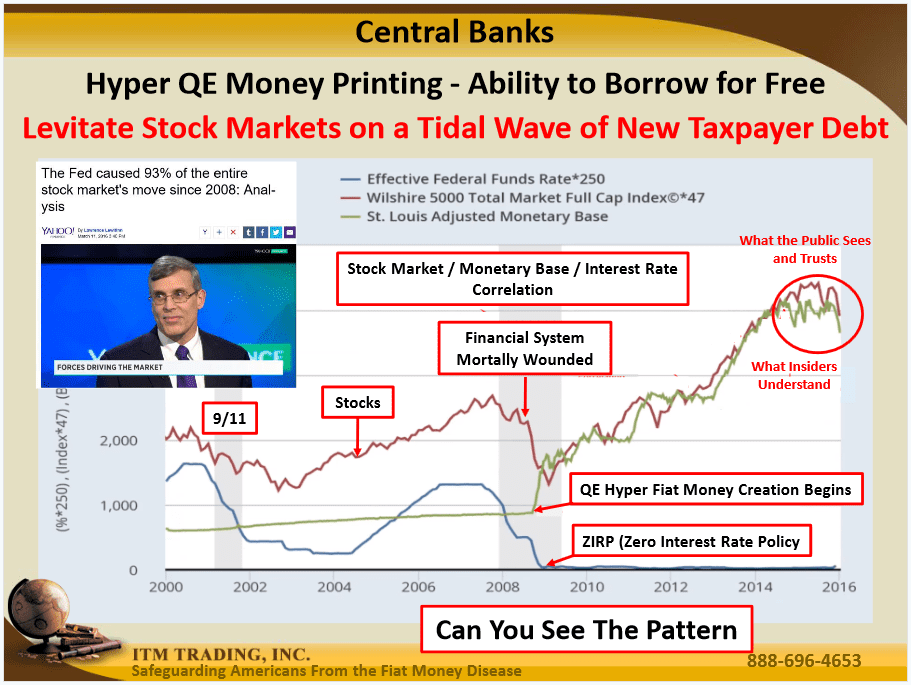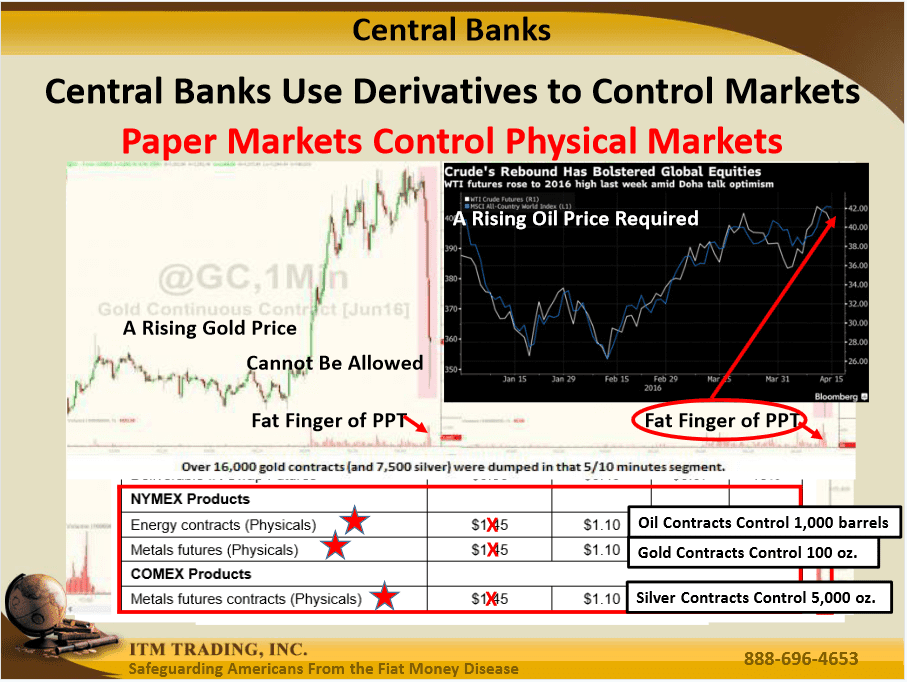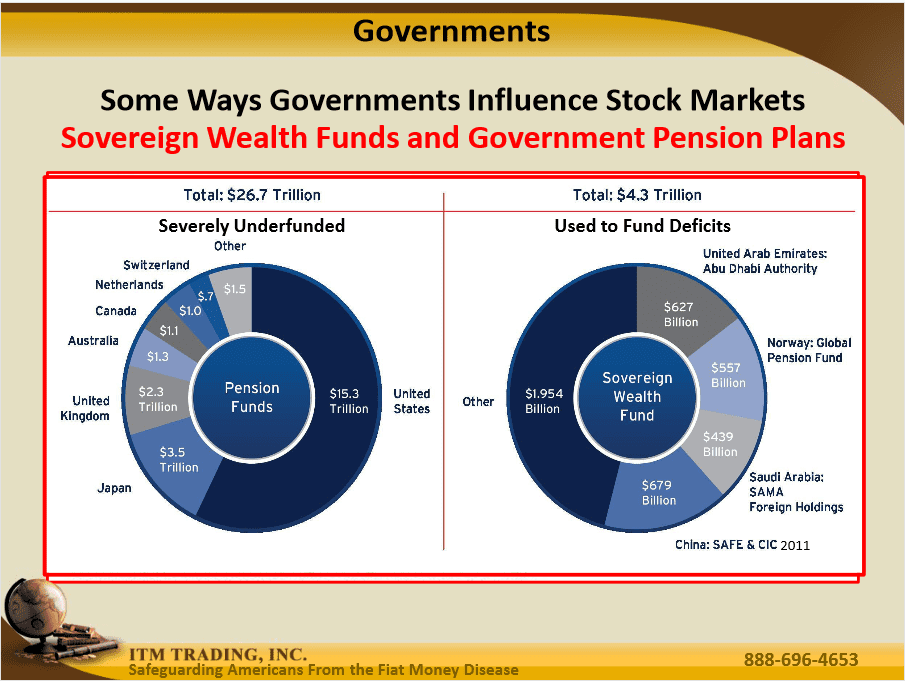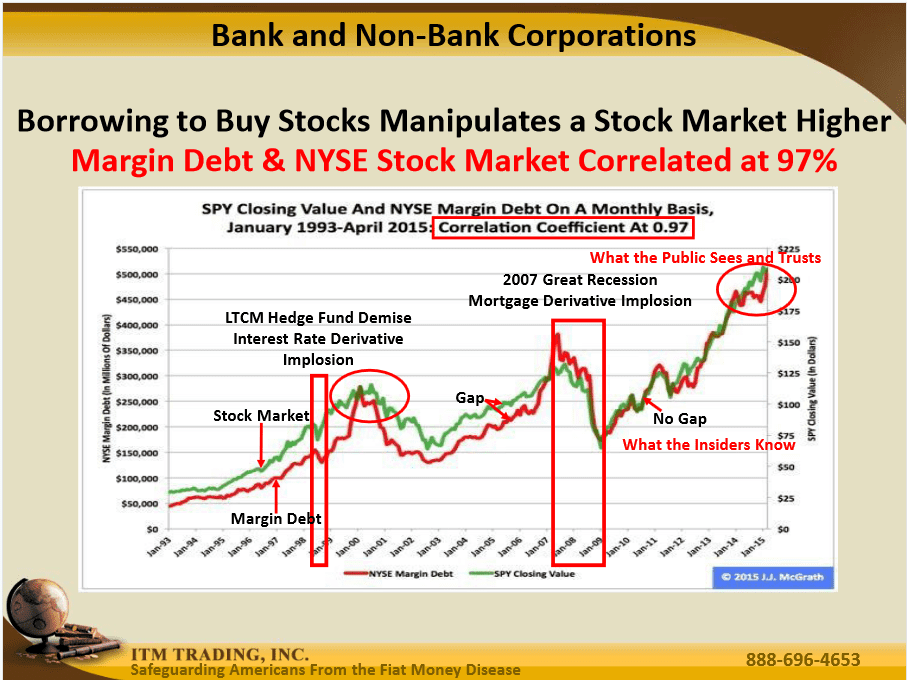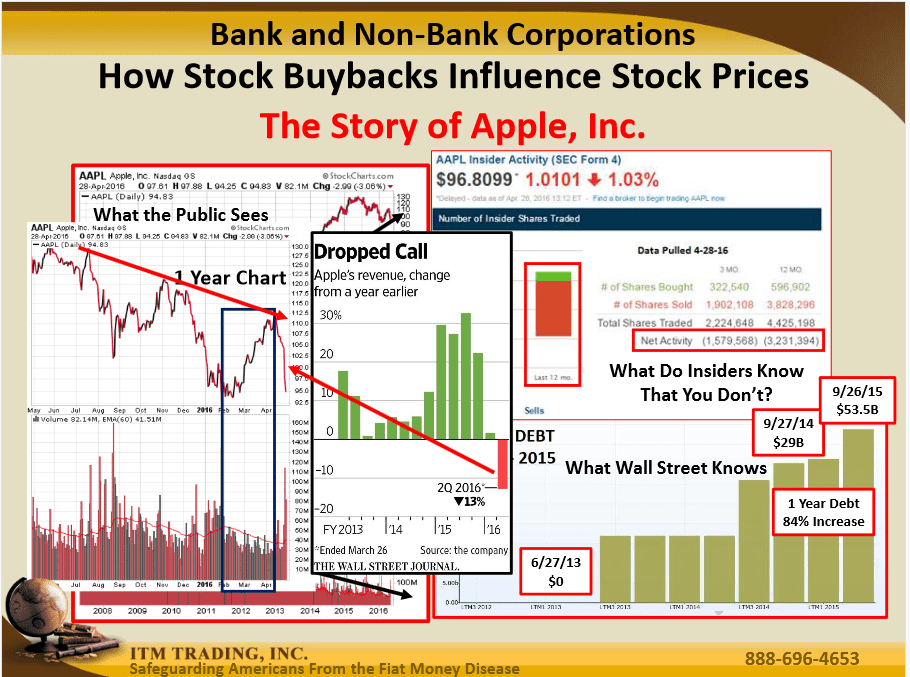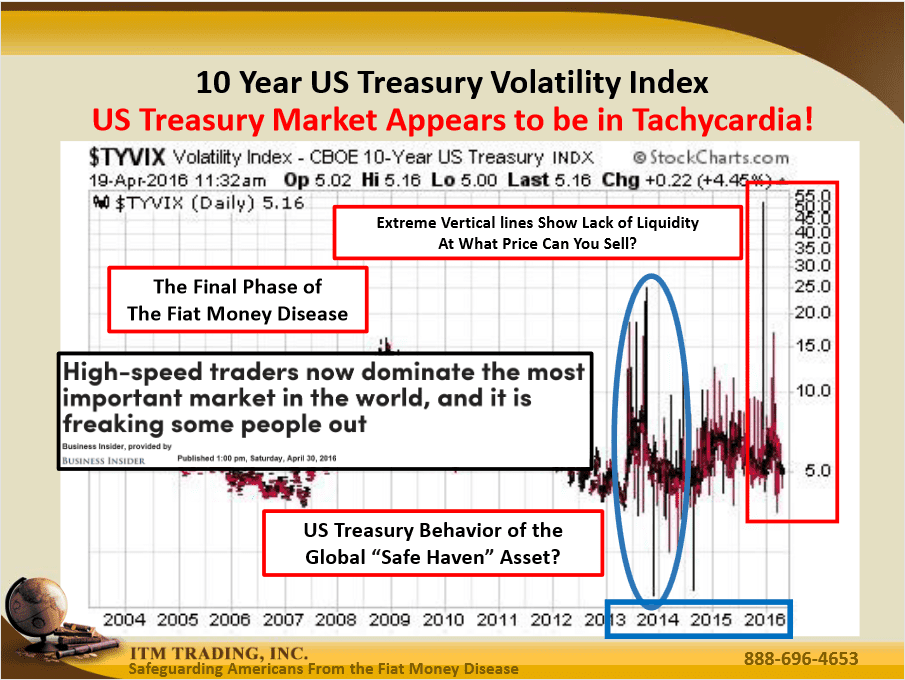If Everything is so Bad Why is the Stock Market so Good

29 Minutes 5 Seconds
 Stock Market Manipulation
Lynette Zang is the Chief Market Analyst at ITM Trading. Lynette has been with ITM Trading since 2002. Lynette came to ITM Trading with quite a bit of market and life experience, as well as a deep desire to help others. Almost fifteen years later, Lynette now hosts webinars designed to convert financial noise into easily understandable language. This article is a brief recap that describes the market manipulation that Lynette describes in her webinar entitled “If Everything is so Bad, Why is the Stock Market so Good?â€
Recently, stock markets have been hitting new all-time highs. According to Lynette, people see these numbers and feel that everything is just fine. But, could these numbers and results be manufactured to keep investors placid and dulled? Could these markets just be an intricate illusion? Lynette has a gift for looking behind the curtain, a la Dorothy in The Wizard of Oz.
Furthermore, Lynette calls what happens behind the curtain “Perception Managementâ€. If perception management exists, then Lynette will try to find strong evidence of it’s existence, and bring it to light. Lynette believes in data. If you ask Lynette a question, you will get an educated and well thought out answer backed up with fact and data.
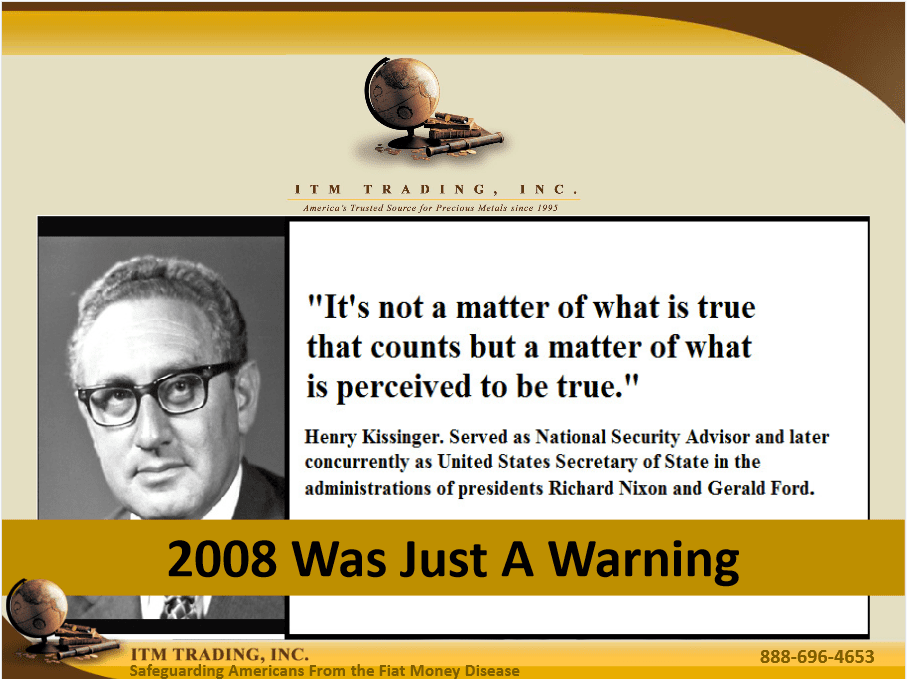
Henry Kissinger Believes In Perception Management.
As far as market manipulation goes, the webinar posits that three groups collude to pull off this caper. These groups are Central Bankers, Governments, and Bank and Non-Bank Corporations. Financial data shows who is participating in these markets, and the results that their participation causes. Each of these three has their own tools of market manipulation, and Lynette tells you all about them.
Market Manipulation : Central Bankers.

Central Bankers Yellen, Draghi, Kuroda, And Carney.
The Central Bankers are the people that run the banks that run the countries around the world. The United States has the Federal Reserve Bank. Currently, the Chair of the Federal Reserve is Janet Yellen. Mario Draghi is the President of the European Central Bank. Haruhiko Kuroda is the Governor of the Bank of Japan. The fourth person in the picture, to the right, is Mark Carney. Mr. Carney is the Governor of the Bank of England. The Peoples Bank of China has been becoming much more important, recently, and Zhou Xiaochuan has been it’s long-time Governor.
Especially relevant are the tools these bankers use, such as “Forward Guidanceâ€, “Quantitative Easing†and “Derivativesâ€. Forward guidance is pretty simple. Forward guidance merely means that the Central Bankers tell you what they are thinking of doing. When one of the five people listed above speak, bankers around the world listen and make strategy adjustments.
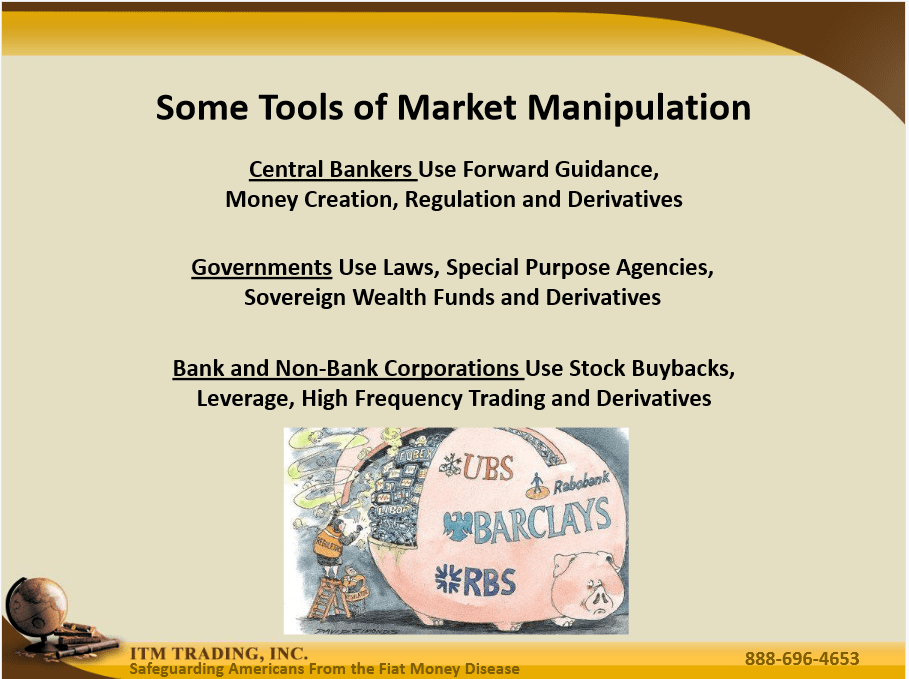
Whether or not the Central Bankers ever do what they say is almost irrelevant. Ironically, just their words can cause desired (or undesired) consequences.
Another thing that Central Bankers are really good at is creating money out of almost nowhere. If normal people tried doing this, the term applied would be “counterfeitingâ€. When a Central Bank creates money, they have different cute names for it “Liquidity Boosting†or “Quantitative Easingâ€. As a result, there is more money chasing after the same goods and services. Economists call this “inflation†or “currency devaluationâ€.
During the last financial collapse, Quantitative Easing was rampant, especially in the United States. A lot of dollars were created and loaned in order fix or hide problems. Those dollars have consequences. Gold can help protect your financial portfolio from those consequences.
Derivatives.
In addition to forward guidance and money printing, the Central Bankers also use a financial newbie known as a “derivative†to manipulate markets and achieve false highs and positive public sentiment. Below is a quick definition. If you find the definition complicated, a less complicated definition would be “ A bet on a betâ€.

Also, Lynette’s webinar explains how the Central Bankers can use relatively inexpensive derivative purchases to move markets that are much larger in financial size.
Quick and inexpensive market manipulation can be achieved through derivatives. The Bank of International settlements began tracking OTC derivatives in 1995. These days, the notional value of outstanding derivatives is over $700 trillion. Perhaps market manipulation has been good to the derivative industry.
 Stock Market Manipulation : Governments.
Governments have their own tools that they use to manage market manipulation. One of these tools is known as a retirement fund. Governments tend to have a lot of employees. Governments tend to get only bigger, too.
Government retirement plans that gather contributions every paycheck grow quickly in size and represent sizable capital. By buying into particular funds or stocks, a government can artificially prop up market numbers. After all, you can always buy success, for a little while.
Besides wielding a big checkbook, a government also has the power to create and direct a Sovereign Wealth Fund. Think of a Sovereign Wealth Fund as an investment plan for a country. Below is a definition.
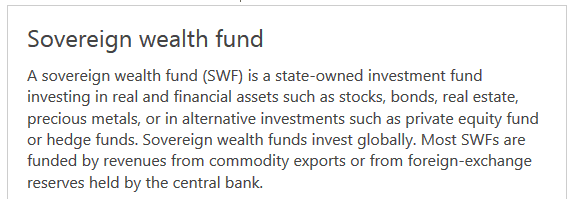
By pointing huge sums of cash and credit at certain funds or investments, a country can cause big swings in the marketplace. Theoretically, if a country wanted to hide particular financial problems in a market that was posting declining numbers, a cash injection of appropriate size might be able to reverse the downward trend and then show rising prices. Rising prices may seem like a good thing in investment markets, but Lynette knows that the reasons why numbers do what they do is more important than the numbers themselves.
Sovereign Wealth Funds.
Sovereign wealth funds were first created back in 2002. In just fourteen short years, Sovereign Wealth Funds have managed to overtake parts of the economy. Japan, for instance, has a stock market similar to that of the US. It has been estimated that Sovereign Wealth Funds may account for up to 90% ownership of the stocks ion this market.
This is a problematic situation. In business, this is what is known as an “illiquid positionâ€. Essentially, there are not enough buyers around should these funds decide to sell. The market is said to be “thin†and the trading “low volumeâ€. If buyers for what you are holding are few and far between, then perhaps the assets you are holding are less valuable than you may think.
Sovereign Wealth Funds may be market manipulation tools, but they may also prove to be financial tools of mass destruction. Time will tell.
Market Manipulation : Bank and Non-Bank Entities.
Banks and non-banks have their own market manipulation tools. Some of these tools were given to the banks and corporations by the Federal Reserve Bank itself. One such tool is free money. Certain banks and corporations can borrow from the government for almost nothing. This is possible because the Fed has set interest rates at or near zero for quite some time now.
When money is free to borrow, banks and corporations tend to focus less on earning money and more on borrowing it. One way that corporations, in particular, use the free money is to buy back their own stock. Borrowing free money and using it to purchase stock ends up artificially boosting the stock price. When company after company does this, you get an entire market of artificially high stock prices.
Until you peel back the curtain to see why companies are buying their own stock, you just see rising markets and rising prices and the tools of perception management are working. Lynette brings up the fact that many CEO’s and corporate big boys have their compensation and bonuses tied to the stock price of the company. As a result, a rising stock price may mean big bonuses while a falling stock price may mean getting fired.
Stock Buy-Backs.
Tying CEO pay to performance seemed like a good idea, but as things have happened, many CEO’s and executives have taken the easy way out and they have temporarily “borrowed†prosperity. Many think that the today’s stock markets are over-valued. ITM Trading agrees.
Lynette also notes a newer process that has cropped up in our financial markets; announcing corporate buy-backs. Much like the Central Bankers use forward guidance to move markets, the corporations announce buy-backs before they disclose their earnings reports. An earnings report is much more like an actual checkbook balance. Announcing a stock buy-back before disclosing an earnings report is kind of like pulling up to the bank in a new Mercedes; it makes your finances look good, even perhaps if they are not.
In some cases, a company buying back it’s own stock makes a lot of financial sense. In other cases, rather, a stock buy-back can be market manipulation meant to hide problematic markets or finances.
Market Manipulation : Apple.
At about the 16:30 minute mark, Lynette makes a great example out of a company you have probably heard about; Apple. Apple changed lives. The phone and the tablet and the PC will never be the same, Apple changed them. But now, Apple is changing. Numbers tell the story. Apple was debt free. Now Apple owes more than $53.5 billion as of 9/15. Apple sales are down. Apple revenue is down, but Apple stock price keeps climbing.
While, if you look at who is buying Apple stock, it is no longer individuals and retirement funds who are the main purchaser. Apple is undergoing a huge stock buy-back program. Meanwhile, those in the know at Apple are selling their stock. Why?
Ultimately, they know that the stock is overvalued. There are no buyers for Apple stock at the current prices, with the exception of Apple, itself. And, Apple is buying it’s own stock with borrowed money. If this sounds like bad economics, it is. Some say the technology and growth at Apple have been souring for a while. Therefore, time will tell if the financial shenanigans at Apple will rot the company to the core.
Market Manipulation : The Ten Year Treasury.
To further illustrate her point about market manipulation, Lynette pointed to the ten-year US Treasury bond. Treasury bonds are used to finance the running of the US government, among other things. The Treasury bond is supposed to be extremely liquid. Being liquid means that an item is easily convertible to cash. In fact, US Treasury bonds are said to be the most liquid of all government issued securities.
Unfortunately for US bond holders, this is not exactly the case. Perhaps most noteworthy in this section of the webinar, is the evidence that Lynette presents which shows that the number of buyers for these bonds has decreased by roughly 70%. If this becomes the long-term trend, then we will have what is known as a “zombie†bond market. The investments are there, but they are not alive. Zombie markets have the ability to crash or go away altogether.
Furthermore, Lynette presents another chart that really scared her, and she spends several minutes explaining it. In essence, high-speed traders and market instability have combined to change the entire landscape of what was once a somewhat solid market. The left side of the chart shows business as usual. The right side of the chart starts to look like what she describes as a “Financial Heart Attackâ€.
Fight  Stock Market Manipulation : Own Physical Gold.

As you can see, perception management is real. A lot of politicians and corporations have vested interests keeping the public fooled. The markets are not OK. The highs are manipulated and gold prices are suppressed. So, don’t get caught looking the wrong way, own gold.
In conclusion, gold has been money and a currency for thousands of years. As a result, gold has become a form of wealth insurance. Gold money should be the foundation of every financial portfolio. ITM Trading has as a strategy in place to help you profit in the long-run. In order to do so, you will need to be at the right place at the right time with the right asset. Physical gold is the right asset.

